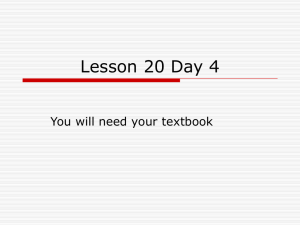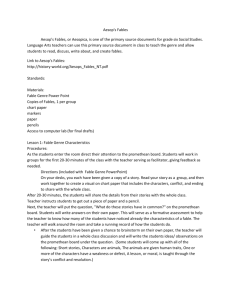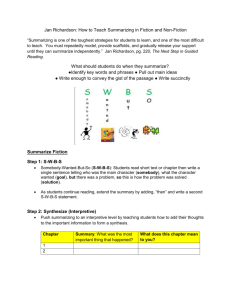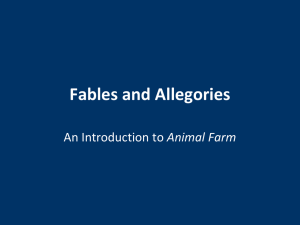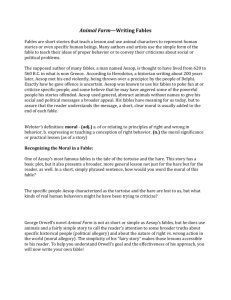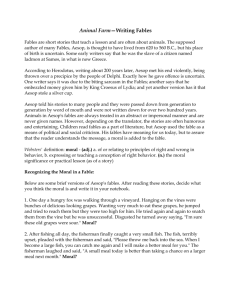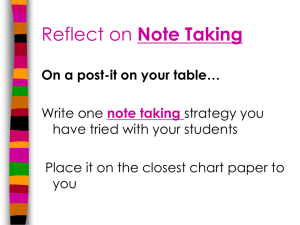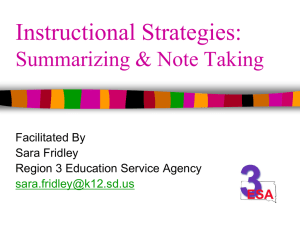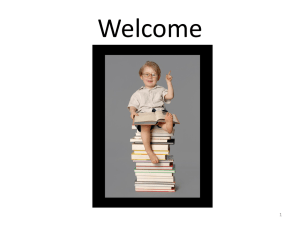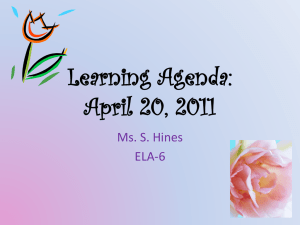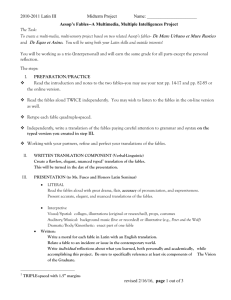Strategy Implementation Report
advertisement
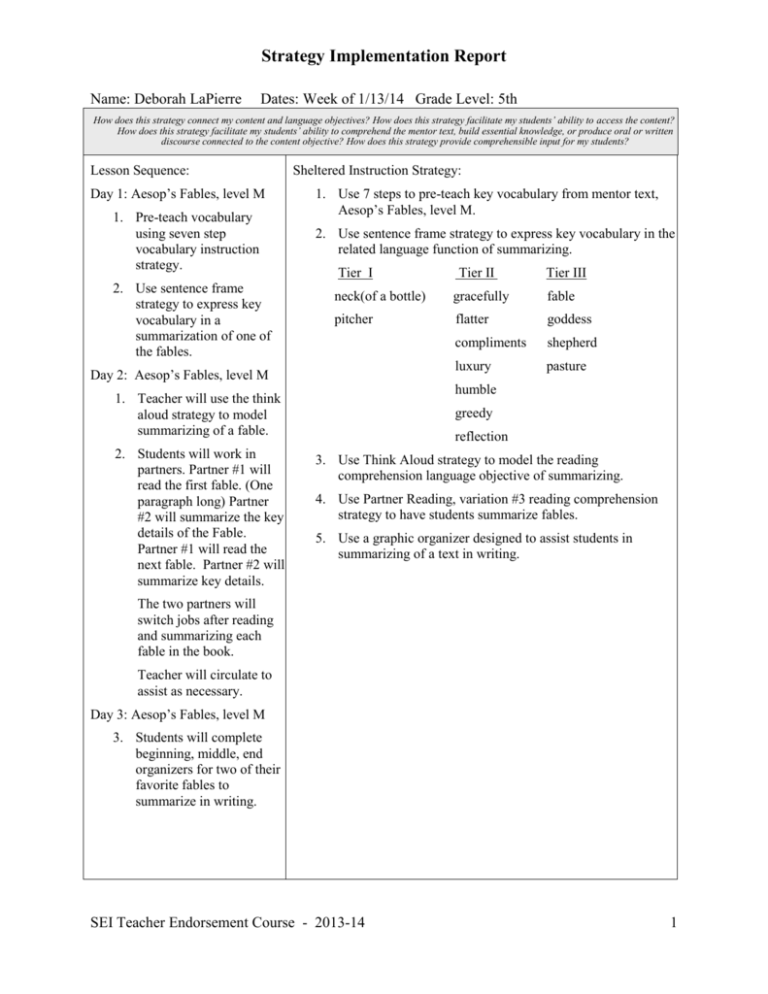
Strategy Implementation Report Name: Deborah LaPierre Dates: Week of 1/13/14 Grade Level: 5th How does this strategy connect my content and language objectives? How does this strategy facilitate my students’ ability to access the content? How does this strategy facilitate my students’ ability to comprehend the mentor text, build essential knowledge, or produce oral or written discourse connected to the content objective? How does this strategy provide comprehensible input for my students? Lesson Sequence: Day 1: Aesop’s Fables, level M 1. Pre-teach vocabulary using seven step vocabulary instruction strategy. 2. Use sentence frame strategy to express key vocabulary in a summarization of one of the fables. Sheltered Instruction Strategy: 1. Use 7 steps to pre-teach key vocabulary from mentor text, Aesop’s Fables, level M. 2. Use sentence frame strategy to express key vocabulary in the related language function of summarizing. Tier I Tier III neck(of a bottle) gracefully fable pitcher flatter goddess compliments shepherd luxury pasture Day 2: Aesop’s Fables, level M humble 1. Teacher will use the think aloud strategy to model summarizing of a fable. 2. Students will work in partners. Partner #1 will read the first fable. (One paragraph long) Partner #2 will summarize the key details of the Fable. Partner #1 will read the next fable. Partner #2 will summarize key details. Tier II greedy reflection 3. Use Think Aloud strategy to model the reading comprehension language objective of summarizing. 4. Use Partner Reading, variation #3 reading comprehension strategy to have students summarize fables. 5. Use a graphic organizer designed to assist students in summarizing of a text in writing. The two partners will switch jobs after reading and summarizing each fable in the book. Teacher will circulate to assist as necessary. Day 3: Aesop’s Fables, level M 3. Students will complete beginning, middle, end organizers for two of their favorite fables to summarize in writing. SEI Teacher Endorsement Course - 2013-14 1 Strategy Implementation Report Content Objective: Language Objective: Language Objectives should be directly linked to the language Students will demonstrate comprehension of traditional literature texts at their instructional reading level. skills students will need to be successful in achieving the content objective. Students will summarize two fables both orally and in writing. Language Objective Differentiation for Proficiency Levels: The students are level 4 students and one level 3 student. I will give the level 3 student sentence strips with starter phrases such as, “So, what just happened is…” and “The first thing that happened is...The next thing that happened is….The last thing that happened is…” I will also offer these starter phrases to my level 4 students because many of them have communication, language, or reading comprehension disabilities. The use of the beginning, middle, and end organizer will assist in scaffolding the students who have difficulty summarizing because of ELL and special education status. Content and Concept Language Integration: How have I integrated all possible domains into my teaching and learning strategies and activities? How did this strategy help to make the content comprehensible to ELLs in my classroom? By using the seven step strategy to pre teach the vocabulary in conjunction with the sentence frame strategy the students are able to better comprehend an unfamiliar genre, the fable. After, the students are being given an opportunity to read the vocabulary words in the context of the sentence frames and in the actual text. This foundation prepares them to listen to me as I “think aloud” or model the summarizing strategy using one of the fables. Then, the students are asked to both read aloud to another student, again reinforcing the use of vocabulary and oral language practice, while the second student is then responsible for demonstrating the comprehension strategy of summarizing. Best of all, the students switch responsibilities after every short fable, so the activity benefits both students in both ways. Finally, on the last day, students are asked to “put all the pieces together” and complete graphic organizers summarizing their two favorite fables. So, the students are integrating all four key domains of language: listening, reading, speaking, and writing. These strategies allowed my students the best possible chance for success in meeting the content objective. How did this strategy help the ELLs in my classroom to produce academic language and discourse? All of these strategies helped the ELL students in my group access the academic vocabulary, and better comprehend this genre on their way to successfully meeting the content objective for the unit. According to Calderon (2009), “strategies for learning vocabulary and strategies for reading comprehension should not be taught separately but in the context of the text students are about to read.” Because my students are both ELL and special education students the difficulty of completing academic tasks is even greater. By utilizing the strategies that I have learned to teach vocabulary reading comprehension in these lessons, my students have had tremendous success with the fable genre. If additional benefit to the students was specifically selected fables at their independent reading levels in order to minimize difficulties in decoding. By using these vocabulary and SEI Teacher Endorsement Course - 2013-14 2 Strategy Implementation Report comprehension strategies and engaging the students in the four components of language they were better prepared to read and comprehend the text. To increase my ELLs’ engagement and interaction, the next time I try this strategy, I would … The next time I try this strategy, I would be more careful about pairing my students. Although I paired strong decoders with weaker ones, I should have been more concerned with pairing stronger summarizers with weaker ones. Because I work with special education students who are also ELL students it is sometimes difficult to pair or group students; some are good decoders and have very weak comprehension skills and others are weak decoders and have very good comprehension skills. I would definitely mix up the pairs next time I try this strategy. Also, next time I would try this strategy using a non-fiction text with more content specific vocabulary. I would be interested to see how this strategy assists with summarizing of non-fiction material. Generally my students are better at summarizing fictional stories than they are summarizing nonfiction texts. The strategy was generally successful in this lesson, but now that the students are familiar with it, I would like to challenge them even more. SEI Teacher Endorsement Course - 2013-14 3
